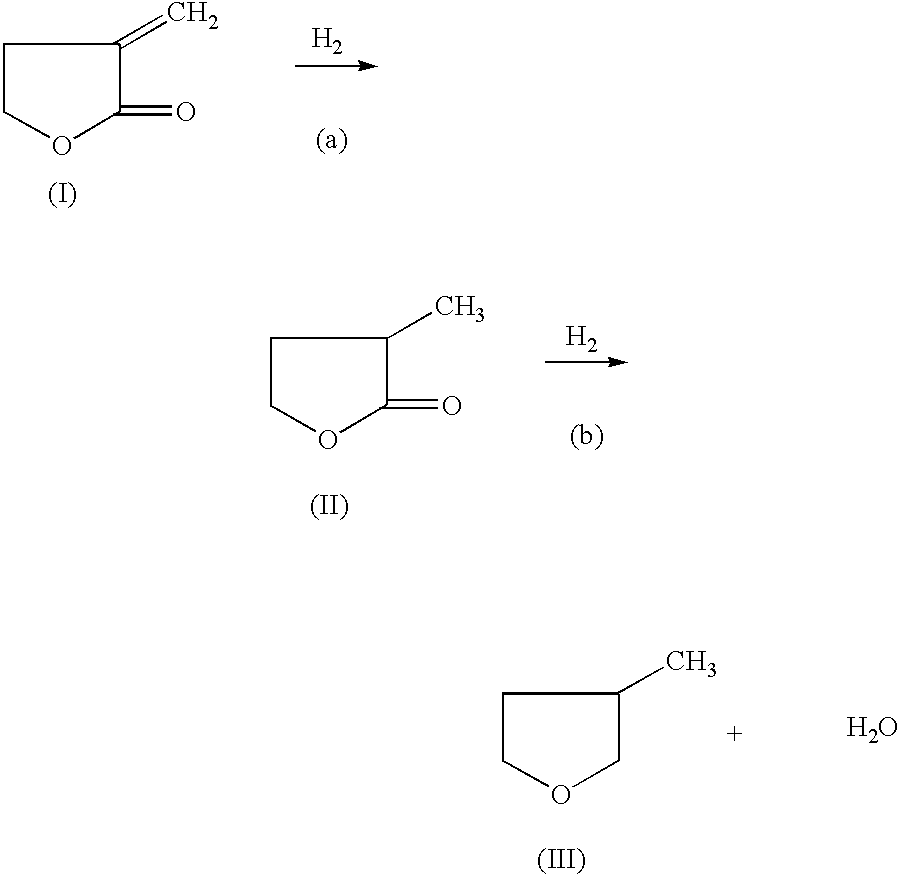Manufacture of 3-methyl-tetrahydrofuran from alpha-methylene-gamma-butyrolactone in a two step process
- Summary
- Abstract
- Description
- Claims
- Application Information
AI Technical Summary
Benefits of technology
Problems solved by technology
Method used
Image
Examples
example-1
[0038] Catalyst Preparation 5% Pt on Acid Washed Calsicat Carbon
[0039] In a 150 ml beaker, a solution was made up of 4.5 ml, 0.3 M H.sub.2PtCl.sub.6 with 4.0 ml deionized H.sub.2O. To the beaker were added 4.75 g Calsicat Acid Washed Carbon (12.times.20 mesh, dried at 120.degree. C. overnight). The slurry was allowed to stand at room temperature for 1 hr with occasional stirring and then dried at 120.degree. C. overnight with frequent stirring (until free flowing).
[0040] In an alumina boat, in a quartz lined tube furnace, the catalyst was purged with 500 SCCM N.sub.2 at room temperature for 15 min and then with 100 SCCM He at room temperature for 15 min. The catalyst was heated to 150.degree. C. and held at 150.degree. C. under He for 1 hr. At this point, 100 SCCM H.sub.2 were added and the sample was held at 150.degree. C. under He and H.sub.2 for 1 hr. The temperature was increased to 300.degree. C. and the catalyst was reduced at 300.degree. C. under He--H.sub.2 for 8 hrs. The H....
examples 1-52
[0041] Hydrogenation of Alpha-Methylene-Gamma-Butyrolactone to 2-Methyl-Gamma-Butyrolactone-Step (a)
[0042] 50% alpha-methylene-gamma-butyrolactone in Dioxane (974.7 mg, 5.0 mmole) and an amount of catalyst with a support as indicated in Table 1, were added to a 2 ml batch reactor. The reactor was sealed and charged with pressure of H.sub.2 at 6.89 MPa for examples 1-8, and 23-26, 4.82 MPa for 14-22 and 27-52, and 1.38 MPa for 9-13, and heated to reaction temperature of 225.degree. C. for examples 1-8, and 23-26, and 150.degree. C. for 12-22 and 27-52, and 100.degree. C. for 9-11. The reaction was stopped after 2 hours for examples 1-7, and 23-52, and at 4 hours for examples 8-22 and rapidly cooled. An internal standard (2-methoxy ethyl ether) was added into the reaction mixture and GC analysis was performed on a HP-6890 GC with a Chrompack column (CP-WAX 58, 25 M.times.0.25 MM). The following table lists the reaction conditions catalyst, acid promoter and conversion and selectivity ...
examples 53-116
[0043] Reduction of 2-Methyl-Gamma-Butyrolactone to 3-Methyl-Tetrahydrofuran-Step (b)
[0044] 50% 2-methyl-.gamma.-butyrolactone in dioxane (970.0 mg, 4.84 mmole) and an amount of catalyst and support as indicated in Table 2 were added to a 2 ml batch reactor. The reactor was sealed and charged with 6.89 MPa of H.sub.2, and heated to 225.degree. C., and then cooled rapidly. The reaction was stopped after 4 hours. An internal standard (2-methoxy ethyl ether) was added to the reaction mixture and GC analysis was performed on a HP-6890 GC with a Chrompack column (CP-WAX 58, 25 M.times.0.25 MM). An acid promoter was not used for examples 53-85. An acid promoter was used for examples 86-116.
3TABLE 2 EXAMPLES 53-85 H.sub.2 2-Me-GBL 3-MeTHF Ex. Time Temp. Pressure Conversion Selectivity No. (hrs) (.degree. C.) (MPa) Catalyst / Support Acid (%) (%) 53. 4 225 6.89 1% Ru / 6% Re / C 19.56 49.12 54. 4 225 6.89 5% Rh / Sibunit C 9.21 12.76 55. 4 225 6.89 5% Pt / Sibunit C 2.12 29.23 56. 4 225 6.89 5% Ru / Ca...
PUM
 Login to View More
Login to View More Abstract
Description
Claims
Application Information
 Login to View More
Login to View More - R&D
- Intellectual Property
- Life Sciences
- Materials
- Tech Scout
- Unparalleled Data Quality
- Higher Quality Content
- 60% Fewer Hallucinations
Browse by: Latest US Patents, China's latest patents, Technical Efficacy Thesaurus, Application Domain, Technology Topic, Popular Technical Reports.
© 2025 PatSnap. All rights reserved.Legal|Privacy policy|Modern Slavery Act Transparency Statement|Sitemap|About US| Contact US: help@patsnap.com



